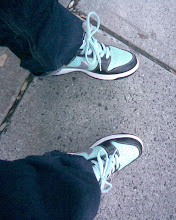Monday, January 26, 2009
Praying hands.
Since my youth, I have long felt little connection to the many visual postures of prayer that often populate our Christian lives. The traditional image set forth of our pleas and petitions to God - two hands pressed lightly against each other, palms gently folded together in quietude and stillness of mind - was so thoroughly static, so devoid of vitality and vivacity, that it assailed even my young, malformed images of entering the Presence.
So it was that, even in my old listless dearth of faith, showing up to church with no pleas, no longings, and no desire for renewal, I began praying with fingers interwoven, hands clenched together, grasping at one another for support and mutual affirmation. Even as my heart and soul shrugged their way methodically, mechanically, through a yet-another (as in, "yet another Sunday service, prayer meeting, family prayer, etc."), at least my body found tension, dynamism, movement. But not growth.
Still, this manual configuration, of digits weaving and palms pressing, was the natural mold into which my hands fell even as I found - again, or for the first time, depending upon whose soteriology and ontology you lean - the brilliance and joy of a life lived in concert with that Holy Love (ἀγάπη τοῦ θεοῦ), the Divine Father, the Great Friend. As my soul began wrestling with Truth - with conflict, with the ideal-real disparity, with the weight and depth of my own sin (and the corresponding value and immensity of Grace) - the twists and turns of my hands were filled with new spiritual life, a physical metaphor of the incredibly more real spiritual struggle and discovery.
Recently, however, I've been rediscovering the classic posture of prayer. It's not that I've altogether abandoned my childhood or the ways of my younger Christian faith in favor of a mature devotion: that would be giving my contemporary practices far too much credit.
Rather, I've unearthed the traditional configuration of praying hands for what it ought to be: these hands are not destined to merely be soft planes joined palm-to-palm in silent, motionless repose. No, they push together, inwards. They splay together, forearms pressing, fingertips tensed against one another; they stand at rest, but not for lack of intensity. No, tension is in them; it may be inherent, or potential. There is potency in each half of a pair of praying hands; they are joined together not of convenience or aesthetic ease, but because the forcefulness of each plane, on its own, needs its twin. And yes, sometimes my joints slide past one another, and the digits interface; but when my hands interlock in this manner, it can often feel as though I have simply come to a conflicted standstill.
When my hands press and push against one another, though - as my thoughts do, as this world and God's Word do - then sometimes I feel my spirit rising up.
Knowing that conflict, even unresolved, does often stand as the breath of wind's currents, pushing up against me, prompting, provoking, pressuring me to less of me, more of You, God.
Subscribe to:
Post Comments (Atom)



No comments:
Post a Comment